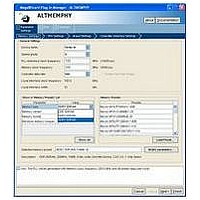IPR-HPMCII Altera, IPR-HPMCII Datasheet - Page 123

IPR-HPMCII
Manufacturer Part Number
IPR-HPMCII
Description
IP CORE Renewal Of IP-HPMCII
Manufacturer
Altera
Datasheet
1.IP-HPMCII.pdf
(176 pages)
Specifications of IPR-HPMCII
Software Application
IP CORE, Memory Controllers, SDRAM
Supported Families
Arria II GX, HardCopy III, Stratix III, Stratix IV
Core Architecture
FPGA
Core Sub-architecture
Arria, HardCopy, Stratix
Rohs Compliant
NA
Lead Free Status / RoHS Status
na
- Current page: 123 of 176
- Download datasheet (4Mb)
Chapter 7: Functional Description—High-Performance Controller II
Block Description
December 2010 Altera Corporation
Configuration and Status Register (CSR) Interface
Error Correction Coding (ECC)
f
1
1
Low-Power Mode Logic
There are two types of low-power mode logic: the user-controlled self-refresh logic
and automatic power-down with programmable time-out logic.
User-Controlled Self-Refresh Logic
When you assert the local_self_rfsh_req signal, the controller completes all
pending reads and writes before it places the memory into self-refresh mode. Once the
controller places the memory into self-refresh mode, it responds by asserting the
acknowledge signal, local_self_rfsh_ack. You can leave the memory in self-refresh
mode for as long as you choose.
To bring the memory out of self-refresh mode, you must deassert the request signal,
and the controller responds by deasserting the acknowledge signal when the memory
is no longer in self-refresh mode.
Automatic Power-Down with Programmable Time-Out
The controller automatically places the memory in power-down mode to save power
if the requested number of idle controller clock cycles is observed in the controller.
The Auto Power Down Cycles parameter on the Controller Settings tab allows you
to specify a range between 1 to 65,535 idle controller clock cycles. The counter for the
programmable time-out starts when there are no user read or write requests in the
command queue. Once the controller places the memory in power-down mode, it
responds by asserting the acknowledge signal, local_powerdown_ack.
HPC II supports only precharge power-down mode and not active power-down
mode.
The configuration and status register interface is a 32-bit wide interface that uses the
Avalon-MM interface standard. The CSR interface allows you to configure the timing
parameters, address widths, and the behavior of the controller for without leveling
interfaces. If you do not need this feature, you can disable it and all the programmable
settings are fixed to the values configured during the generation process. This
interface is synchronous to the controller clock.
The CSR interface is not fully supported for DDR3 SDRAM with leveling interfaces,
such as DIMMs.
Refer to
register maps.
The optional ECC logic comprises an encoder and a decoder-corrector, which can
detect and correct single-bit errors, and detect double-bit errors. The ECC logic is
available in two widths: 64/72 bit and 32/40 bit. The ECC logic has the following
features:
■
Hamming code ECC logic that encodes every 64 or 32 bits of data into 72 or 40 bits
of codeword.
Table 7–9
through
Table 7–23
Section II. DDR3 SDRAM Controller with ALTMEMPHY IP User Guide
in
page 7–18
for detailed information about the
External Memory Interface Handbook Volume 3
7–7
Related parts for IPR-HPMCII
Image
Part Number
Description
Manufacturer
Datasheet
Request
R

Part Number:
Description:
IP NIOS II MEGACORE RENEW
Manufacturer:
Altera
Datasheet:

Part Number:
Description:
IP CORE Renewal Of IP-XAUIPCS
Manufacturer:
Altera
Datasheet:

Part Number:
Description:
IP CORE Renewal Of IP-10GETHERNET
Manufacturer:
Altera
Datasheet:

Part Number:
Description:
IP CORE Renewal Of IP-ASI
Manufacturer:
Altera
Datasheet:

Part Number:
Description:
IP CORE Renewal Of IP-CIC
Manufacturer:
Altera
Datasheet:

Part Number:
Description:
IP CORE Renewal Of IP-CRC
Manufacturer:
Altera
Datasheet:

Part Number:
Description:
IP CORE Renewal Of IP-ED8B10B
Manufacturer:
Altera
Datasheet:

Part Number:
Description:
CPLD, EP610 Family, ECMOS Process, 300 Gates, 16 Macro Cells, 16 Reg., 16 User I/Os, 5V Supply, 35 Speed Grade, 24DIP
Manufacturer:
Altera Corporation
Datasheet:

Part Number:
Description:
CPLD, EP610 Family, ECMOS Process, 300 Gates, 16 Macro Cells, 16 Reg., 16 User I/Os, 5V Supply, 15 Speed Grade, 24DIP
Manufacturer:
Altera Corporation
Datasheet:

Part Number:
Description:
Manufacturer:
Altera Corporation
Datasheet:










